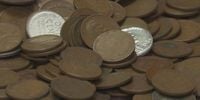The penny, that humble copper coin, has jingled in American pockets, piggy banks, and cash registers for over two centuries. But as of November 15, 2025, the U.S. Mint officially ended its production, closing a chapter that began all the way back in 1793. The decision, announced by the Trump administration earlier this month, comes after years of debate about the penny’s practicality and cost. For many, it’s the end of an era—one marked by thrift, luck, and a small but persistent piece of American identity.
“It’s an emotional day,” admitted Clayton Crotty, a 15-year veteran at the Philadelphia Mint, as the final penny was struck in a ceremony attended by press and Mint officials. The moment was steeped in nostalgia, but also relief. Crotty’s sentiment echoed throughout the building as Mint workers marked the last pressing with quiet reverence before breaking into applause, according to the Associated Press.
Why end the penny now? The answer, it turns out, is both practical and financial. Stephanie Grove, director of retail at Belmont Savings Bank, summed up the dilemma: “It costs about 4 cents to produce each penny that's only worth a penny.” With nearly four cents spent to make a coin valued at just one, the economics simply didn’t add up. Treasurer Brandon Beach, who presided over the final minting, estimated that ending penny production would save taxpayers a whopping $56 million annually.
President Donald Trump, who ordered the phaseout earlier this year, put it bluntly: “For too long, the United States has minted pennies that cost more than their worth.” The move follows a precedent set by other countries—Canada, for example, phased out its penny in 2012—and brings the U.S. in line with a growing global trend.
Yet, for all the logic behind the decision, the penny’s departure is more than just a matter of math. It’s a cultural moment, too. Pennies have long been seen as lucky tokens, cherished by collectors, and even woven into the fabric of local traditions. At Texas A&M University, students have for decades placed pennies at the feet of the Sul Ross statue before exams, hoping for a bit of good fortune. “I’m actually really upset by that. The penny has so much history, and there’s so much culture around it here too,” said sophomore Shlok Amin, speaking to KBTX.
For many Aggies, the end of the penny means scrambling to stockpile enough coins to keep the tradition alive. “As a college student, I’m already kind of pinching my pennies,” joked freshman Brooke Muller. “I’ll be keeping those with me and hopefully having enough pennies to keep the tradition alive over the next 4 years.” The Sul Ross statue, for now, remains an altar of luck, even as new pennies stop rolling off the presses.
Coin collectors and dealers are also paying close attention. Steve Chaney, co-owner of Brazos Coin and Jewelry, predicts a surge in interest—and possibly value—for the penny now that it’s obsolete. “There’s a lot more interest now, people saving pennies for collectibility,” Chaney observed. But he cautioned that the penny might not be the only coin facing extinction. “They’re saying that it costs eight, almost nine cents to make a nickel. I would think that the nickel’s probably going to be next on the chopping block.”
Still, not everyone expects a sudden windfall. Brett Charville, owner of Toledo Coin Exchange, pointed out that with an estimated 250 billion pennies still in circulation, rarity—and thus value—will come slowly, if at all. “We don't really think we're going to be affected,” Charville said, noting that only pennies minted in 1958 or earlier might be worth extra to collectors. For most folks, the pennies in their pockets are likely to stay just that—pocket change.
On the retail side, businesses are adapting in different ways. SoFo’s Italian Market in Toledo, Ohio, has already begun rounding cash transactions to the nearest five cents. Owner Tony Feudi reported that less than 10% of his customers pay with cash, and most barely notice the change. “It really has gone… almost unnoticed, with only minimal reaction from most customers,” Feudi told local reporters. The financial impact? “So minimal” that no further adjustments are planned.
Big box chains like Kroger have also adjusted, while local grocery stores such as Reisbeck’s have yet to change their operations. For now, it’s mostly business as usual, though some retailers have started rounding prices or offering small prizes for pennies to encourage their continued use. Jeff Lenard, a spokesperson for the National Association of Convenience Stores, has long supported ending the penny, citing benefits like faster transactions and cost savings.
Banks are also taking the news in stride. Donnie Sheller, executive VP and CEO of Main Street Bank, reassured customers that there’s no need to panic. “If customers have coin, they should continue to use it, just as they have in the past,” said Grove of Belmont Savings Bank. Both institutions are still receiving penny supplies from the Federal Reserve and expect to process pennies for decades to come. Sheller offered a practical tip: “What I would tell people is if you have a check, it would be best to deposit that check or at least deposit the cents of that check to make sure you're getting the full value of your money.”
Officials have advised against hoarding pennies as keepsakes, suggesting instead that people exchange them for proper currency. “The longer they're in circulation, the longer they're going to be around for banks,” Sheller noted. With billions of pennies still out there, the coin’s disappearance from daily life will be gradual, not sudden.
For historians and numismatists, the penny’s end marks more than just a financial decision; it’s a moment of reflection on national identity. Frank Holt, emeritus professor at the University of Houston, put it this way: “Pennies record our politics, art, religion, and the people we choose to honour. They are a tiny reflection of our national identity.”
As the last coins produced are displayed for the press and prepared for auction to collectors, Americans are left to ponder the legacy of the penny—a coin that, for generations, carried more than just monetary value. Whether tucked away in a jar, left at the foot of a statue, or exchanged at the checkout, the penny’s story is now, finally, history.

